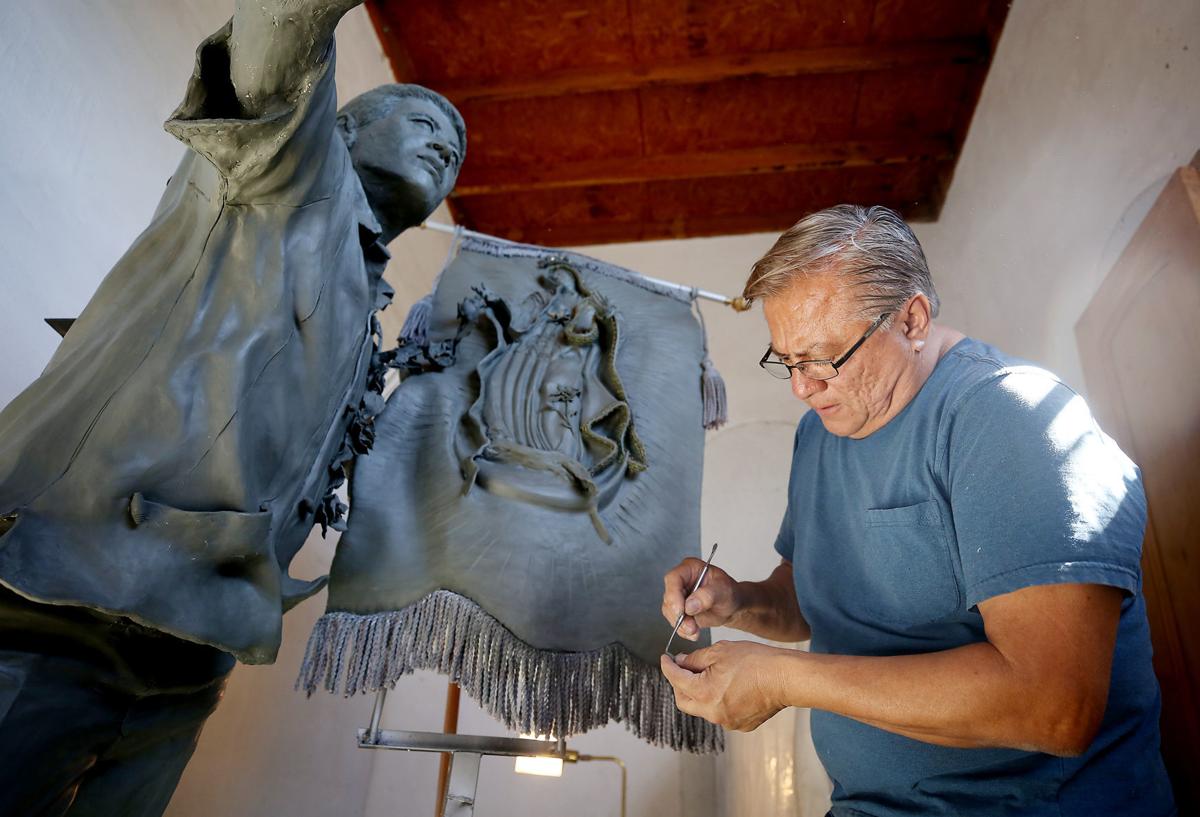In the front-room art studio of Luis Gustavo Mena’s Barrio Anita house stands a statue, a work in progress.
The 6-foot figure is of a man with slight, indigenous facial features. His right arm extends outward, holding two clusters of grapes. His left arm wraps behind a banner, bordered with thick fringe, of the Virgin of Guadalupe. The man’s shirt and banner appear to be buffeted by wind, but he, with hopeful eyes looking toward the heavens, appears determined to move forward.
The statue is of César E. Chávez, a leading figure in environmental and workers’ rights, an icon in the Chicano political movement and co-founder of the United Farmworkers Union.
And if all works out, the statue will be erected near downtown, making it the first in Tucson to honor Chávez, who died 26 years ago on April 23 in San Luis, Arizona.
“My objective was to bring out his spirituality,” said Mena, a Tucson native who has created several other public sculptures and murals in Tucson. “I wanted to take it to another level.”
The still-clay statue, which has yet to be molded in bronze, would be erected at the Five Points intersection, where South Stone and South Sixth avenues meet at 18th Street.
The statue will be placed on a 6-foot-tall base, facing south, on the spot where the old “Ugly But Honest” sign of Wanslee Auto Sales currently stands. Although Chávez was not 6 feet tall, Mena said he made the statue taller so it could stand out.
The statue is part of a larger art project planned for Five Points by the city’s Transportation Department.
In addition to the Chávez statue, five steel arches, which will carry the names of the neighborhoods and Five Points, will span the streets leading to the intersection, and 10 panels reflecting local folklore and people will also be erected.
The project, however, has frustrated Mena and its supporters.
Pedro Gonzales, a longtime activist and resident of Barrio Viejo, said city officials have stalled on the project and failed to be transparent. He said project planning began in 2006 and the design committee selected Mena to create the artwork in 2014. Since then, there have been delays and restarts, he said.
“I personally think the city doesn’t want to do the project,” said Gonzales, who wrote a critical letter to City Manager Michael Ortega in October 2018. In the letter, co-signed by other barrio residents, Gonzales urged Ortega to order city staff to step up their work and honor the commitment to the project and Mena’s contract.
“Luis can’t commit to anything else. They’re holding him hostage,” Gonzales said.
But Jesse Soto, project coordinator with the Transportation Department, said the project’s delays were out of the city’s control.
“We feel we have been diligent. It will be completed,” Soto said.
The city decided to redo the intersection, a major entryway to downtown Tucson. The city enlisted Barrios Viejo and Santa Rosa in the project, as well as the Armory Park neighborhood and Five Points business owners.
During the first years of the nearly $700,000 project, the city improved the intersection’s infrastructure. Following that was the art-selection process that involved the neighborhoods, the city and the Tucson Pima Arts Council, now known as the Arts Foundation for Tucson and Southern Arizona.
After the artists and their projects were selected, additional review of the projects resulted in delays, Soto said. The designs for the panels, which contained images of indigenous peoples, were sent to nine tribes across the state for their review. That took two years, he said. In addition, the state Department of Transportation had to weigh in with its review, adding more time to the delay, Soto added.
Now that the major hurdles have been overcome, Soto said, “We finally are getting traction on this.”
Ward Five council member Richard Fimbres, who has been involved in the planning process, attributed the delays to “hiccups.”
“I want to make sure it goes up,” Fimbres said. “It’s going to happen.”
A statue honoring Chávez is long overdue for Tucson. He was born in the Yuma area, and while he lived most of his life in California, organizing poorly paid and poorly treated agricultural workers, Chávez often visited Tucson.
Yet there are few public recognitions of him in the city. Across the street to the west of where the statue will be placed is a stamp-sized park dedicated to Chávez; the South Sixth Avenue bridge crossing Interstate 10 has artwork in his honor; the University of Arizona has the César E. Chávez building next to Old Main. And the city of Tucson has a paid Chávez holiday for employees, and the county has an unofficial day devoted to Chávez.
As for statues of Chávez elsewhere across the country, there are not many, said Ruben Reyes, an aide to Congressman Raúl Grijalva and a member of the Arizona César E. Chávez Holiday Coalition.
Mena, who has sculptures at the central fire station and at the foot of Sentinel Peak, and has murals downtown and in the cafeteria at Davis Bilingual Elementary Magnet School in Barrio Anita, said the Chávez work is his most satisfying.
He has long admired Chávez and supported his efforts in bringing social justice to workers and barrio residents. In his studio, he has the book, “The Gospel of César Chávez: My Faith in Action.”
“I went into a trance when I was sculpting,” he said. “It seems like my spirit kicked in.”
After he puts the final touches on his sculpture, Mena will cut it into pieces and send them to the foundry, Metalphysic Sculpture Studio on East 44th Street, east of the Veterans Hospital. There, other artists will create bronze cast molds, and the statue will be pieced together.
By the end of the year, Mena’s creation will be placed on its pedestal.
If there are no more delays.





